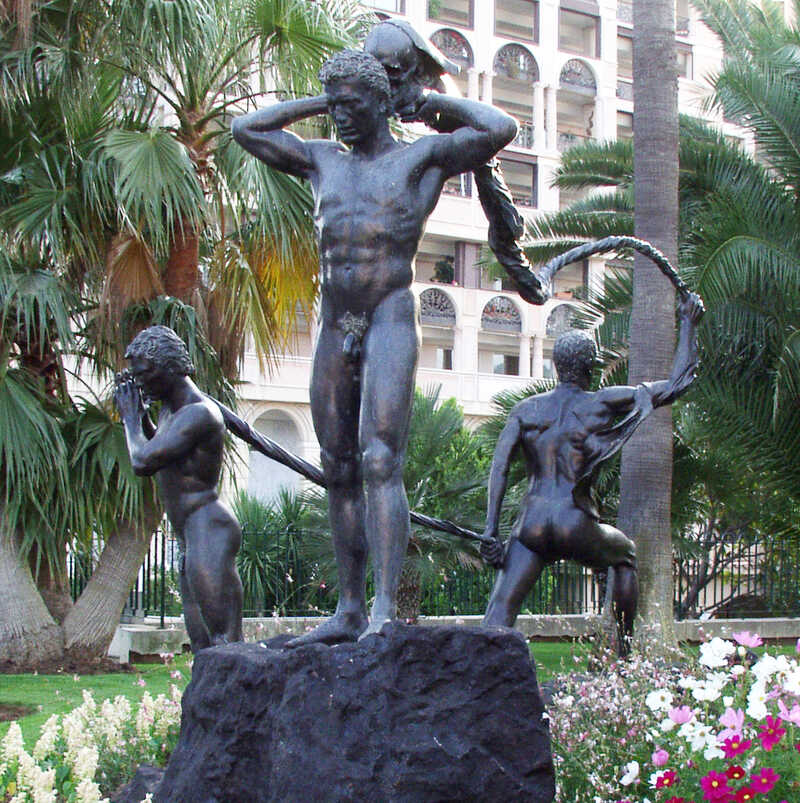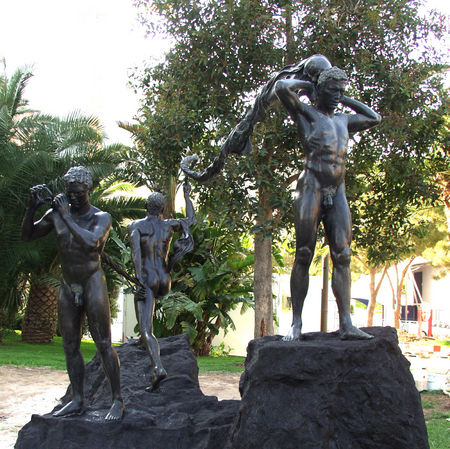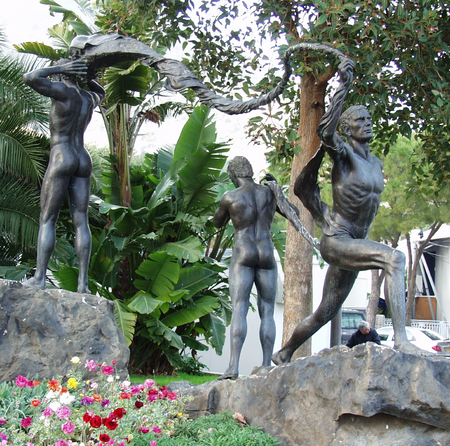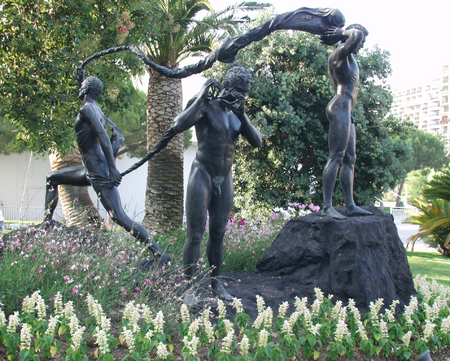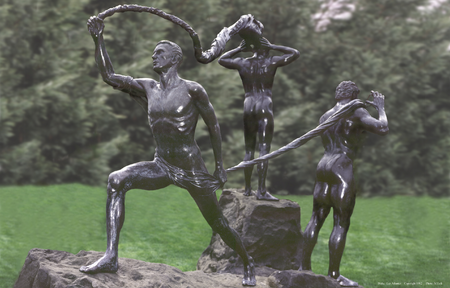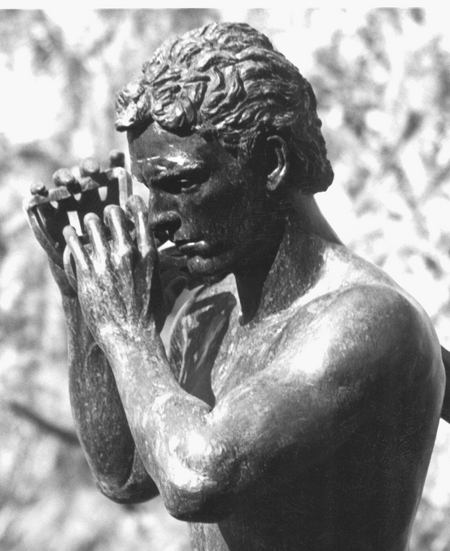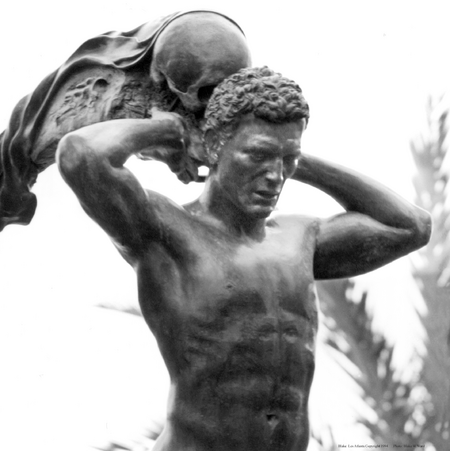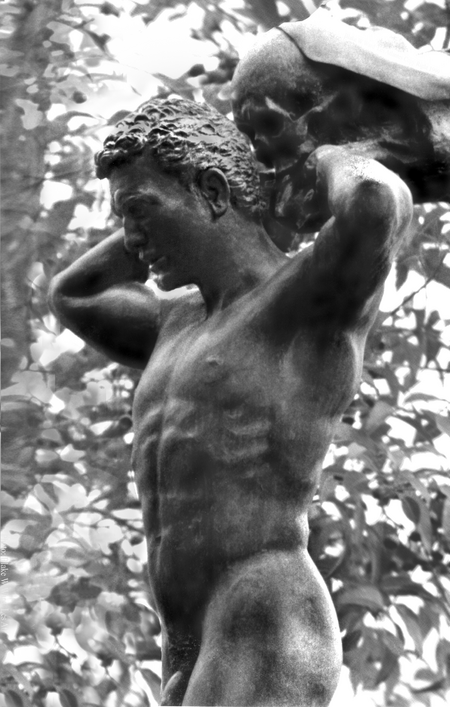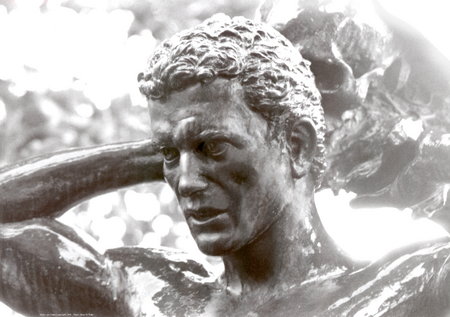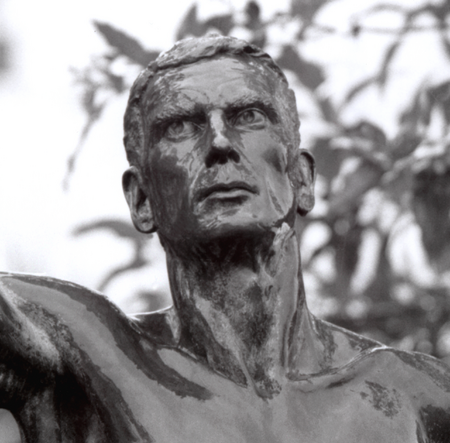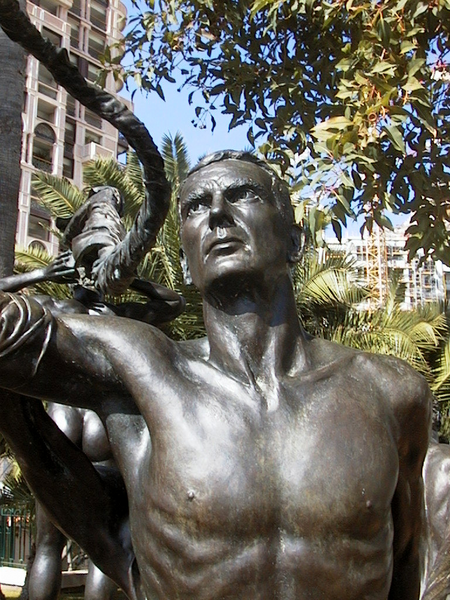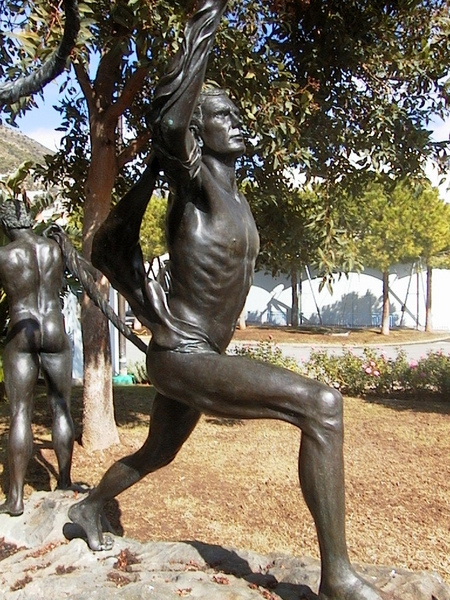ReThink Collection
Les Atlantes
This, among all of the sculptures I have created stands as an example of chasing phantoms within my art. This work is a type of spiritual quest for me, and is among the first to comment on an idea of spirituality and our inner selves. It symbolises the spirit that encompasses our existence and informs our beliefs and faith.
Entitled; Les Atlantes, the work is composed of a triad of life-size male figures in a celebration of life. That this work would speak of the ancient symbols of “threeness”, unity of the body, of mind, and the spirit, the three stages of spiritual life known to the worlds’ different faiths: the purification of the heart, divine illumination, and union with our spirit. Or perhaps simply the majesty of life, its passing, and finally its loss in death.
Height 295cm x Width 386cm x Depth 452cm
Les Atlantes
"Les Atlantes" is dedicated to the celebration of life. Depicted, are three men representing various aspects of physical, emotional and spiritual existence. The directions in which they travel are opposing and their only contact remains a cloth, which both bind them and simultaneously represents their history and burden. Within this fabric is found the promise of love, faith, as well as hope and finally the courage that is a required element in each man’s life. This symbolic bronze cloth is the bridge between man and spirit, the woven history of each man’s life, of all that we have created and of all which we have come to understand. Confronting their destiny before them, their story speaks of the flesh through the silence of the spirit.
The youngest, wears the expression of hope and wonder, the infallible innocence of youth, displaying the courage to carve his history among the uncertainty in this world. With the enthusiasm and anticipation of youth, he takes a position of attack, his body inclining against the weight of his encumbrance. Each hand strains to hold in its grasp, a symbol of an uncertain, and illusive, future. Retreat is impossible and the past, he carries with him, has just begun to unfold.
The older, carries the weight of his history with determination, both his struggle and accomplishments trailing in his wake. Advancing, he gazes steadily forward into the future before him, knowing the pain of defeat and the elusive glory of victory. The path he has chosen, now unforgiving, remains as unalterable as the responsibilities he shoulders without respite. The hollow skull hangs over him filled with his fear of the past and the expected. The memories and theories that have been his existence will soon be evident only in the vacant eyes that stare down upon him.
The elder, advances with strides that defy his limits, marching like time. He commands his charge without fear or impediment and holds above him the cloth that becomes a mantel to cover him, as a symbol of his faith supporting our fragile and ephemeral existence. He might be the incarnate of spirit, a Holy Ghost portrayed in human form, in itself a transgression of ecclesiastical law. Thus depicted, his presence would emphasize the vulnerability of many religions and the misuse of this conviction.
The spirit is not found in man’s written words of God nor in a likeness given here to a man, but in the history that every man creates, a God that each man will know and to the knowledge and love that survives him.
I can see only man before me, and in his nature the spirit that drives him and the achievements that set him apart from his origins.
This work is dedicated to the history that every man creates, to the God that each man loves, and to the knowledge which each leave in passing. We know only the stone, the cloth, and the flesh, we must trust in the spirit.
Other Critical Writing
Les Atlantes by Ms Jane Floren 1993
Constantly fascinated by the theme of mankind's journey through life, artists have sought to capture the essence through song, story and art. Here in this powerful living mausoleum is a young sculptor's concept of life and death.
The drapery is the heart of the work. There are three figures traveling in opposing directions, on different levels, and requiring different space. The cloth is the connecting link, the family unit represented, the supporting structure, as an armature supports a sculptural work in progress. These figures stand alone, but are bound by love, hope faith and courage.
Life is woven of many threads depicting the challenges of the years, and each man creates his own history. Hidden in the folds of the cloth are articles of war, knowledge, religion, honours, roots, wings, and technological miracles.
From the Spirit in man's image flows the gift of life, carried by the weaving from father to son. The Spirits stride depicts the relentless march of time. His direction is unhesitatingly forward; his gaze heavenward.
In this bronze group, the woven cloth that the father bears is a thickening mass, constructed as it is by hopes and accomplishments, challenges and failures across many years. He carries his mortality with him, represented by the skull, accepting it, but literally putting it behind him. His face reflects the strength he has brought to his quest.
The physically perfect son leans against his lighter load, holding in his hand the symbol of eternity, infinity. All life is before him, he advances in his own direction, unaware that the heel of his foot is trapped against the rock and retreat in time is impossible.
Here is the celebration of life, seen in a captured moment as fleeting as the last light of a falling star, frozen in bronze and time.
Critical Writing
Les Atlantes by Vincent Roberts Paris 1995
There is nothing apocalyptic about Blakes' work. There is no evidence of fear, famine or war, no signs of "big diseases with small names," no end of the world pessimism and guilt. Here is an artist who shows us elegance and beauty in their most natural form with permanence.
To sculpt the human body obliges the artist into humanism, not as an ideal, not something to be intellectualized but rather something to be lived, experienced whilst the experience remains a permanent thing, tangible. It is imbibed with the human spirit. The work is classic, of the nature that knows no time, only space. Like the spirit, the human body has not changed over the time, and is not likely to do so. Thus we return to the ever renewing yet unchanging human form, static but ever moving; that miracle, and the key to this imposing and dramatic work.
Seen first through the smallest of the three Atlantes; the young adult, enthusiastic in his attack, enthusiastic towards life. Before him there are no frontiers, no limitations to his hopes, his dreams, his life. He carries upon his shoulder, with force and effort all that the past ages can offer him in terms of knowledge, culture, hope and aspiration. He stands on the edge of time, ahead is only space and the unknown, but not doubt. By his side stands a second Atlante, a larger and older figure, he too carries the weight of his history. Having been that younger man and come to know his own frailties, his mortality, he carries this loss of innocence, bravely with strength and spirit though death be his constant companion.
Facing away from the first two Atlantes is a Spirit; a transparent figure of advancing years, commanding his relationship with the world at large, moving upward and away from the attachments of pain and suffering of the human condition. He has known the joys of life, impassioned youth and later remorse.
Yet so imbibed by the certainty of Spirit is he that his acceptance of the inevitable renders him no longer vulnerable to the lower realms of consciousness; he has gone beyond matter into the Spirit. This going beyond the material; beyond matter is represented by the cloth, dense and mortal where it concerns the second Atlante, heavy as the grave, an enormous weight to bear, becomes lighter and transparent when passing through the last of the figures only to flow on to the youngest Atlante a charge of knowledge, an invisible history of evolving facets, be they dense or light spiraling to the windblown lightness of our existence.
Critical Writing
Les Atlantes by Ronald Martens 1994
Constantly fascinated by the theme of mankind's journey through life, artists have sought to capture the essence through song, story and art. Here in this powerful living piece is a young sculptor's concept of life and death.
The weaving is the heart of the work. There are three figures traveling in opposing directions, on different levels, and requiring different space. The cloth is the connecting link, these figures stand alone, but are bound by love, hope faith and courage.
Life is woven of many threads depicting the challenges of the years, and each man creates his own history. Hidden in the folds of the cloth are articles of war, knowledge, religion, honors, roots, wings, and technological miracles.
From the Spirit in man's image flows the gift of life, carried by the weaving from father to son. The Spirits stride depicts the relentless march of time. His direction is unhesitatingly forward; his gaze heavenward.
In this bronze group, the woven cloth that the father bears is a thickening mass, constructed as it is by hopes and accomplishments, challenges and failures across many years. He carries his mortality with him, represented by the skull, accepting it, but literally putting it behind him. His face reflects the strength he has brought to his quest.
The physically perfect son leans against his lighter load, holding in his hand the symbol of eternity, infinity. All life is before him, he advances in his own direction, unaware that the heel of his foot is trapped against the rock and retreat in time is impossible.
Here is the celebration of life, seen in a captured moment as fleeting as the last light of a falling star, frozen in bronze and time.
Nice matin March 1994
Fontvieille Blake et les Atlantes
Installé en principauté depuis trois ans le sculpteur canadien prête l’une de ses œuvres pour décorer les pelouses de l’héliport.
"Les atlantes", ces trois personnages de bronze qui ornent les jardins de Fontvieille proche de l’héliport sont l’œuvre d’un jeune sculpteur canadien, Blake Ward installé en principauté depuis trois ans.
Curieuse trajectoire que celle de ce plasticien qui a étudié son art durant douze ans dans son pays et à Rome puis a Paris ou il possède une galerie.
Ce jeune artiste a participé à de nombreuses expositions dont" le génie de la bastide et le salon des indépendants au grand palais" à Paris.
Sa première démarche l’a dirigé vers l’art abstrait. Il créait des volumes harmonieux se jouant de l’espace, à l’instar d’artistes qu’il aime et qu’il respecte. Mais son amour de l’être humain l’a poussé a contre courant a revenir à la sculpture figurative, un retour aux sources.
Car il vénère en effet Michel Ange, le Bernin, Houdon, Carpeaux, Dalou et Rodin qui à travers leurs œuvres, ont légué une magnifique leçon de sincérité. De cette tradition figurative est venue la nécessité pour Blake de quitter le Canada pour l’Europe, afin d’étudier les grands maitres italiens et français de la renaissance à nos jours. Il a choisi Monaco, charnière entre la France et l’Italie pour son climat, sa lumière et aussi pour l’intérêt que la famille princière et l’Etat portent à tous les Arts.
Dans son atelier à Fontvieille, depuis trois ans, Blake Ward donne ainsi corps à des figures de toute beauté. Le jeune artiste considère à juste titre que l’accomplissement d’un sculpteur est la réalisation d'un "groupe" à célébrer la vie en composant une œuvre imposante : "les atlantes": trois hommes portant a bout de bras la morts symbolisée par un crâne et un linceul renfermant les secrets du temps passé dont chacune des fibres tissées aboutit vers cette issue inéducable.
Deux atlantes vont avec sérénité dans la même direction, alors que le dernier marque opiniâtrement son refus ,mais ne peut reculer, accentuant ainsi cette dualité entre la vie et la mort
C’est dans la région que Blake Ward recrute la plus part de ses modèles. Ainsi l’un des atlantes est un rugby man niçois…
Jacques Ginepro
Nice Matin March 1994 English Translation
Fontvieille Blake and the Atlantes
Living in the principality for three years, the Canadian sculptor has placed one of his sculptures to decorate the lawn at the heliport.
"Les Atlantes" the three bronze figures adorning the gardens of Fontvieille, near the heliport, are the work of a young Canadian sculptor Blake Ward who settled in the principality three years ago.
A curious path for this artist who has studied art for twelve years in his country, as well as in Rome and then Paris where he has a gallery.
The young artist has participated in numerous exhibitions such as; "Le Génie De La Bastille" and "Le Salon Des Indépendants at the Grand Palais in Paris.
His first work was directed towards abstraction. He created harmonious volumes playing with the space, even though it was not like the artists he loves and respects. But his love for humanity has brought him back to figurative sculpture, returning to his origins.
For he is inspired by the work of Michelangelo, Bernini, Houdon, Carpeaux , Rodin and Dalou, who through their work have left a wonderful example of sincerity. This figurative tradition required Blake to leave Canada for Europe in order to study the great Italian and French masters of the Renaissance as well as contemporary artists. He chose Monaco, situated between France and Italy for its climate, its light and also for the interest that the Princes family and the State have in all the arts.
In his studio in Fontvieille, Blake Ward has worked for three years creating these figures of beauty. The young artist considers the realization of this imposing group of statues celebrating life, an accomplishment towards fulfilling the role of a sculptor. " Les Atlantes " portray three men carrying their history behind them, symbolized by a skull and a shroud containing the secrets of their past, representing the burden they carry and the outcome of each man’s life.
Two “Atlantes” go calmly in the same direction as the last one stubbornly refuses but can only move forward, accentuating the duality between life and death .
Blake recruits his models locally. Thus one of the Atlantes currently plays rugby for Nice.
